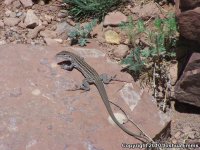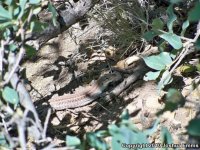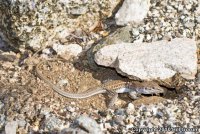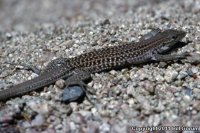| Range: |
 |
| Other Names: |
|
| Description: |
A medium-sized (up to 100 mm or 3.9" from snout to vent), slim, gray-brown to orange-brown lizard with a long, thin tail, and a slim, pointed snout. The body is marked with six (rarely seven) muted, light gray-brown, stripes and numerous light spots. The spots become a vibrant, bright yellow color on the hind limbs and lower back. The tail is olive-gray. The underside is plain and pale. Young animals lack spots and have more distinct stripes. The scales on the body are small and granular. The scales on the tail are large, keeled, and rectangular. The scales on the belly are large, smooth, and rectangular. The scales on top of the head are large, smooth, and plate-like. |
| Similar Species: |
The spotted and striped parthenogenetic species of whiptails all look very similar. The Gila Spotted Whiptail is typically darker-colored dorsally, not as profusely spotted and has 6 (rarely 7) distinct light stripes which tend to be more brightly colored on the anterior portions of the body. Its tail is greenish or bluish, and it typically has 2 enlarged pre-anal scales. The Sonoran Spotted Whiptail is slightly smaller, tends to be darker dorsally, and is less heavily spotted, with 6 well-delineated light stripes; the tail often has an orange tint, and this species typically has 3 pre-anal scales. |
| Venom: |
None |
| Habitat: |
Primarily an inhabitant of Madrean Evergreen Woodland and Semidesert Grassland communities but this lizard also enters the lower reaches of Petran Montane Conifer Forest. It is usually encountered in relatively moist areas such as canyon bottoms, drainages, and riparian corridors. |
| Behavior: |
This is an alert, diurnal, fast-moving ground-dweller. It is often encountered in the morning foraging or basking in the sun. |
| Hibernation: |
It hibernates during the cold months of winter and late fall. |
| Reproduction: |
All Chihuahuan Spotted Whiptails are female (parthenogenetic). Eggs are unfertilized and hatchlings are clones of the mother. Clutches of 1 to 6 eggs are laid in summer. |
| Diet: |
It actively forages by rooting around in organic matter under bushes and digging in the soil around the bases of rocks, and other surface debris. Prey consists of termites, beetles, other insects, spiders, and scorpions. |
Adapted from account on reptilesofaz.org
Sources:


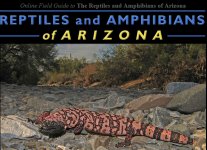
|




